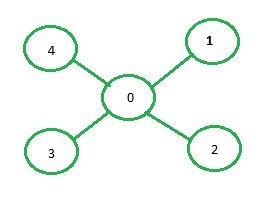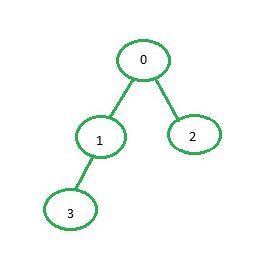Implementation of DFS using adjacency matrix
Last Updated : 20 Mar, 2023
Depth First Search (DFS) has been discussed in this article which uses adjacency list for the graph representation. In this article, adjacency matrix will be used to represent the graph.
Adjacency matrix representation: In adjacency matrix representation of a graph, the matrix mat[][] of size n*n (where n is the number of vertices) will represent the edges of the graph where mat[i][j] = 1 represents that there is an edge between the vertices i and j while mat[i][j] = 0 represents that there is no edge between the vertices i and j.

Below is the adjacency matrix representation of the graph shown in the above image:
0 1 2 3 4 0 0 1 1 1 1 1 1 0 0 0 0 2 1 0 0 0 0 3 1 0 0 0 0 4 1 0 0 0 0
Examples:
Input: source = 0

Output: 0 1 3 2 Input: source = 0

Output: 0 1 2 3 4
Approach:
- Create a matrix of size n*n where every element is 0 representing there is no edge in the graph.
- Now, for every edge of the graph between the vertices i and j set mat[i][j] = 1.
- After the adjacency matrix has been created and filled, call the recursive function for the source i.e. vertex 0 that will recursively call the same function for all the vertices adjacent to it.
- Also, keep an array to keep track of the visited vertices i.e. visited[i] = true represents that vertex i has been visited before and the DFS function for some already visited node need not be called.
Below is the implementation of the above approach:
C++ // C++ implementation of the approach #include <bits/stdc++.h> using namespace std; // adjacency matrix vector<vector<int> > adj; // function to add edge to the graph void addEdge(int x, int y) { adj[x][y] = 1; adj[y][x] = 1; } // function to perform DFS on the graph void dfs(int start, vector<bool>& visited) { // Print the current node cout << start << " "; // Set current node as visited visited[start] = true; // For every node of the graph for (int i = 0; i < adj[start].size(); i++) { // If some node is adjacent to the current node // and it has not already been visited if (adj[start][i] == 1 && (!visited[i])) { dfs(i, visited); } } } int main() { // number of vertices int v = 5; // number of edges int e = 4; // adjacency matrix adj = vector<vector<int> >(v, vector<int>(v, 0)); addEdge(0, 1); addEdge(0, 2); addEdge(0, 3); addEdge(0, 4); // Visited vector to so that // a vertex is not visited more than once // Initializing the vector to false as no // vertex is visited at the beginning vector<bool> visited(v, false); // Perform DFS dfs(0, visited); } // Java implementation of the approach import java.io.*; class GFG { // adjacency matrix static int[][] adj; // function to add edge to the graph static void addEdge(int x, int y) { adj[x][y] = 1; adj[y][x] = 1; } // function to perform DFS on the graph static void dfs(int start, boolean[] visited) { // Print the current node System.out.print(start + " "); // Set current node as visited visited[start] = true; // For every node of the graph for (int i = 0; i < adj[start].length; i++) { // If some node is adjacent to the current node // and it has not already been visited if (adj[start][i] == 1 && (!visited[i])) { dfs(i, visited); } } } public static void main(String[] args) { // number of vertices int v = 5; // number of edges int e = 4; // adjacency matrix adj = new int[v][v]; addEdge(0, 1); addEdge(0, 2); addEdge(0, 3); addEdge(0, 4); // Visited vector to so that // a vertex is not visited more than once // Initializing the vector to false as no // vertex is visited at the beginning boolean[] visited = new boolean[v]; // Perform DFS dfs(0, visited); } } // This code is contributed by kdeepsingh2002 # Python3 implementation of the approach class Graph: adj = [] # Function to fill empty adjacency matrix def __init__(self, v, e): self.v = v self.e = e Graph.adj = [[0 for i in range(v)] for j in range(v)] # Function to add an edge to the graph def addEdge(self, start, e): # Considering a bidirectional edge Graph.adj[start][e] = 1 Graph.adj[e][start] = 1 # Function to perform DFS on the graph def DFS(self, start, visited): # Print current node print(start, end = ' ') # Set current node as visited visited[start] = True # For every node of the graph for i in range(self.v): # If some node is adjacent to the # current node and it has not # already been visited if (Graph.adj[start][i] == 1 and (not visited[i])): self.DFS(i, visited) # Driver code v, e = 5, 4 # Create the graph G = Graph(v, e) G.addEdge(0, 1) G.addEdge(0, 2) G.addEdge(0, 3) G.addEdge(0, 4) # Visited vector to so that a vertex # is not visited more than once # Initializing the vector to false as no # vertex is visited at the beginning visited = [False] * v # Perform DFS G.DFS(0, visited); # This code is contributed by ng24_7
using System; using System.Collections.Generic; class GFG { // adjacency matrix static List<List<int>> adj; // function to add edge to the graph static void addEdge(int x, int y) { adj[x][y] = 1; adj[y][x] = 1; } // function to perform DFS on the graph static void dfs(int start, List<bool> visited) { // Print the current node Console.Write(start + " "); // Set current node as visited visited[start] = true; // For every node of the graph for (int i = 0; i < adj[start].Count; i++) { // If some node is adjacent to the current node // and it has not already been visited if (adj[start][i] == 1 && (!visited[i])) { dfs(i, visited); } } } static void Main(string[] args) { // number of vertices int v = 5; // number of edges int e = 4; // adjacency matrix adj = new List<List<int>>(v); for (int i = 0; i < v; i++) { adj.Add(new List<int>(v)); for (int j = 0; j < v; j++) { adj[i].Add(0); } } addEdge(0, 1); addEdge(0, 2); addEdge(0, 3); addEdge(0, 4); // Visited vector to so that // a vertex is not visited more than once // Initializing the vector to false as no // vertex is visited at the beginning List<bool> visited = new List<bool>(v); for (int i = 0; i < v; i++) { visited.Add(false); } // Perform DFS dfs(0, visited); } } // This code is contributed by Prince Kumar let ans=""; // JavaScript implementation of the Graph class class Graph { constructor(v, e) { this.v = v; // number of vertices this.e = e; // number of edges // initialize the adjacency matrix with 0s this.adj = Array.from(Array(v), () => new Array(v).fill(0)); } // function to add an edge to the graph addEdge(start, end) { // considering a bidirectional edge this.adj[start][end] = 1; this.adj[end][start] = 1; } // function to perform DFS on the graph DFS(start, visited) { // print the current node ans = ans +start + " "; // set current node as visited visited[start] = true; // for every node of the graph for (let i = 0; i < this.v; i++) { // if some node is adjacent to the current node // and it has not already been visited if (this.adj[start][i] === 1 && !visited[i]) { this.DFS(i, visited); } } } } // driver code const v = 5; // number of vertices const e = 4; // number of edges // create the graph const G = new Graph(v, e); G.addEdge(0, 1); G.addEdge(0, 2); G.addEdge(0, 3); G.addEdge(0, 4); // visited array to ensure that a vertex is not visited more than once // initializing the array to false as no vertex is visited at the beginning const visited = new Array(v).fill(false); // perform DFS G.DFS(0, visited); console.log(ans); The time complexity of the above implementation of DFS on an adjacency matrix is O(V^2), where V is the number of vertices in the graph. This is because for each vertex, we need to iterate through all the other vertices to check if they are adjacent or not.
The space complexity of this implementation is also O(V^2) because we are using an adjacency matrix to represent the graph, which requires V^2 space.
Similar Reads
Depth First Search or DFS for a Graph In Depth First Search (or DFS) for a graph, we traverse all adjacent vertices one by one. When we traverse an adjacent vertex, we completely finish the traversal of all vertices reachable through that adjacent vertex. This is similar to a tree, where we first completely traverse the left subtree and
13 min read
DFS in different language
Iterative Depth First Traversal of Graph Given a directed Graph, the task is to perform Depth First Search of the given graph.Note: Start DFS from node 0, and traverse the nodes in the same order as adjacency list.Note : There can be multiple DFS traversals of a graph according to the order in which we pick adjacent vertices. Here we pick
10 min read
Applications, Advantages and Disadvantages of Depth First Search (DFS) Depth First Search is a widely used algorithm for traversing a graph. Here we have discussed some applications, advantages, and disadvantages of the algorithm. Applications of Depth First Search:1. Detecting cycle in a graph: A graph has a cycle if and only if we see a back edge during DFS. So we ca
4 min read
Difference between BFS and DFS Breadth-First Search (BFS) and Depth-First Search (DFS) are two fundamental algorithms used for traversing or searching graphs and trees. This article covers the basic difference between Breadth-First Search and Depth-First Search.Difference between BFS and DFSParametersBFSDFSStands forBFS stands fo
2 min read
Depth First Search or DFS for disconnected Graph Given a Disconnected Graph, the task is to implement DFS or Depth First Search Algorithm for this Disconnected Graph. Example: Input: Disconnected Graph Output: 0 1 2 3 Algorithm for DFS on Disconnected Graph:In the post for Depth First Search for Graph, only the vertices reachable from a given sour
7 min read
Printing pre and post visited times in DFS of a graph Depth First Search (DFS) marks all the vertices of a graph as visited. So for making DFS useful, some additional information can also be stored. For instance, the order in which the vertices are visited while running DFS. Pre-visit and Post-visit numbers are the extra information that can be stored
8 min read
Tree, Back, Edge and Cross Edges in DFS of Graph Given a directed graph, the task is to identify tree, forward, back and cross edges present in the graph.Note: There can be multiple answers.Example:Input: GraphOutput:Tree Edges: 1->2, 2->4, 4->6, 1->3, 3->5, 5->7, 5->8 Forward Edges: 1->8 Back Edges: 6->2 Cross Edges: 5-
9 min read
Transitive Closure of a Graph using DFS Given a directed graph, find out if a vertex v is reachable from another vertex u for all vertex pairs (u, v) in the given graph. Here reachable means that there is a path from vertex u to v. The reach-ability matrix is called transitive closure of a graph. For example, consider below graph: GraphTr
8 min read
Variations of DFS implementations